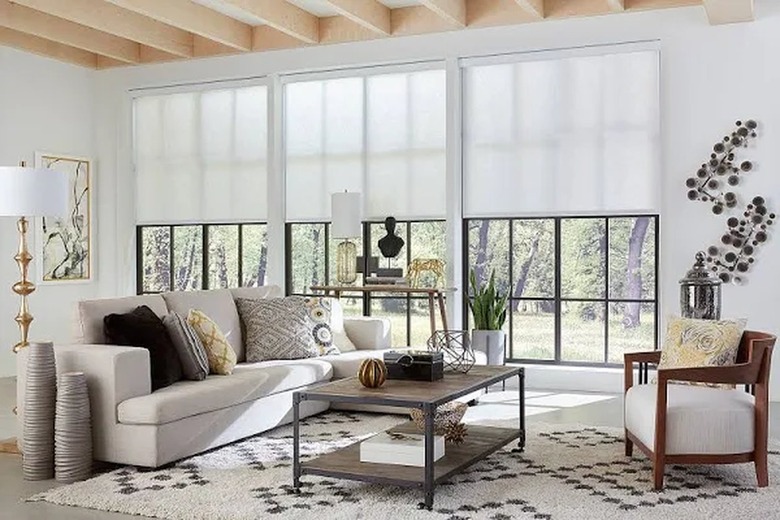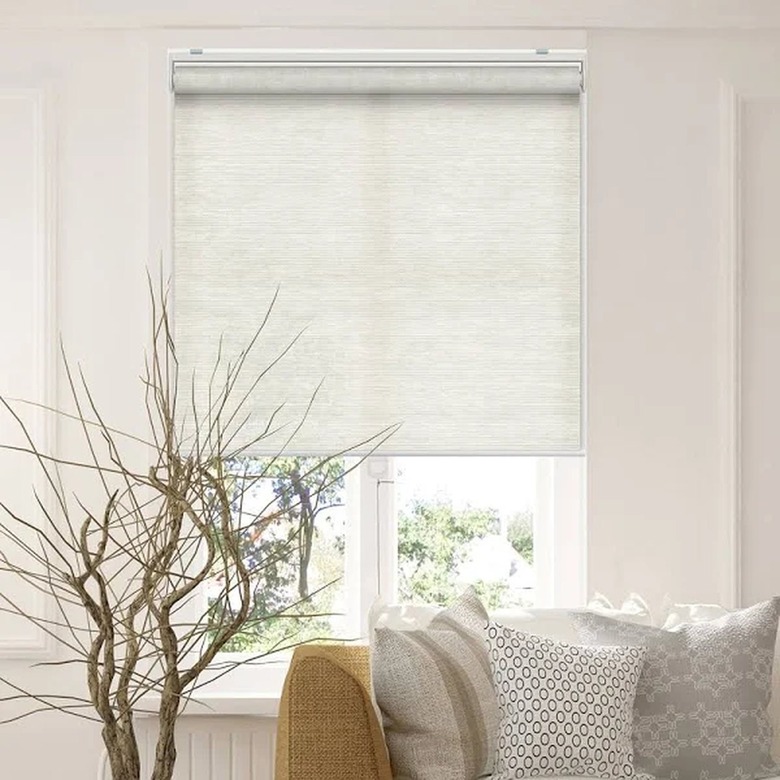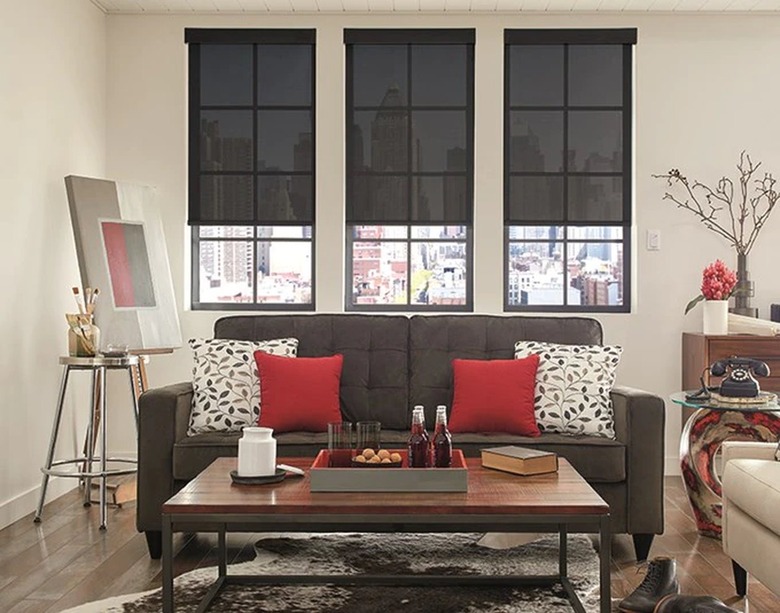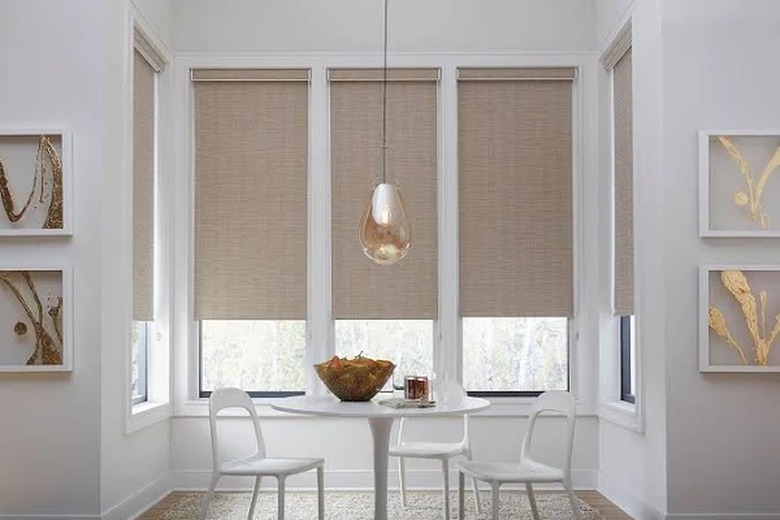What's The Difference Between Roller And Solar Shades?
We may receive a commission on purchases made from links.
Choosing the right window treatments not only pulls together the look of your room but also gives you the right amount of sun filtration and privacy — and solar and roller shades offer versatile options for covering your windows. On the surface, roller and solar shades look very similar, but with a little investigation, you can spot the differences and decide which option is best for you.
Tip
Roller shades and solar shades are both solid sheets that roll up and down around a tube rolling mechanism. The main difference is the special material used for solar shades, which is a woven, meshlike fabric to block UV rays.
What Are Roller Shades?
What Are Roller Shades?
Roller shades are simple window coverings using a solid sheet of thin material without slats or sections. A tubelike roller mechanism sits at the top of the roller shade with the fabric wrapping around the tube. The shade portion can be made from a variety of fabrics, including natural and synthetic materials, with a range of colors and patterns available. You can also choose the opacity you want, including blackout roller shades to completely darken your room. Some roller shades have a headrail as a decorative finish to hide the roller mechanism and give it a polished look.
What Are Solar Shades?
What Are Solar Shades?
Solar shades are simply a type of roller shade. Like all roller shades, a solar shade uses one long, flat piece of fabric instead of having slats, cells, or other sections that other types of blinds and shades sometimes use. The main defining characteristic is the material that's used to make solar shades. It's a woven fabric, almost like a mesh screen, that's designed to block and control UV rays while still maintaining part of the view out your window.
Solar shade fabric is described by levels of openness, which refers to the tightness of the weave and how much light it lets into your room. A lower number, usually between 3 and 5 percent, represents a tight weave, meaning it blocks more light, offers more privacy, and protects against UV rays. However, it also blocks more of the view. Shades with a 14 percent openness level are usually the highest option, allowing for the best view through the shade. These higher level solar shades are mainly used to reduce glare rather than to protect against UV damage. Medium shades, ranging from 7 to 10 percent, give you a balance, protecting from fading and damage while giving you more of a view than low-openness shades.
Types of Roller Shades
Types of Roller Shades
You can find different types of shades that fall under the roller shade umbrella. Solar shades are the main subtype, but you can also categorize roller shapes by their opening mechanism. Some use a continuous cord loop, where you pull on one side of the loop to open it and the other side to close it. This style is especially common on shades for large windows.
Instead of lift cords, some shades use a spring roller mechanism, which works by gently tugging the bottom edge to open the shade and simply pulling it down to close it. Another cordless option is a motorized roller shade that you control with a remote or smartphone app. These cordless lift roller shades work well when babyproofing your home to eliminate dangerous cords that pose a strangulation risk.
Roller Shade Costs
Roller Shade Costs
Solar and roller shades come in a range of prices to fit most budgets. Roller shades typically cost between $8 and $190 each plus labor costs of $35 to $100 per hour if you choose to have them professionally installed. For eight roller shades taking roughly four hours to install, the project cost ranges between $200 and $1,920 total, with an average cost of $1,100.
Solar shades are slightly more than other roller shades, with an average cost of $25 to $200 each. The labor rates for installation are roughly the same, bringing the total cost for eight solar shades to a range of $340 to $2,000, with an average total of $1,170.
Pros of Roller Shades
Pros of Roller Shades
If you're considering roller shades, looking at the pros helps you decide if you can benefit from them. The main perks of installing roller window shades include:
- Affordability: Roller shades are a budget-friendly window covering option, especially if you choose a lower-end option and install the shades yourself.
- Versatility: You can choose the opacity and style that work best for each space while still having the unifying roller design throughout your house.
- Easy operation: The simple controls let you open and close the shades smoothly, and you can easily stop the shades at any height.
- Protection from UV rays: All roller shades provide some protection from the sun, but solar shades especially protect against fading and UV damage.
- Less visible when open: Roller shades can disappear almost completely when fully opened since the material rolls around the tube at the top. This gives you a clear view and a clean look around your window area.
- Light control: Regular roller shades come in all light control options, including light filtering, room darkening, and blackout, to meet needs in different areas of the home.
Cons of Roller Shades
Cons of Roller Shades
Even though roller shades have distinct advantages, there are some drawbacks. Consider the cons of roller shades, which include:
- Less privacy: Solar shades particularly don't provide much privacy at night. Pairing them with drapes is an easy solution. Other roller shades, such as blackout fabric and room-darkening shades, offer more privacy at night.
- Modern look: While many people like a clean, modern look, some homes, such as Victorian-style houses, look better with more traditional window coverings.
- Limited sizes: Roller shades often don't work well for narrow windows or on an odd-shaped window.
- Potential for gaps: Some roller shades leave a slight gap between the shade and the window frame or between multiple shades on side-by-side windows.
- Less insulation: While you can get some thicker blackout shades, roller shades generally don't offer much insulation. Heavy drapes or curtains are often better for insulation to slow heat and cold transfer in both directions.
- Less formal look: Even though they're available in a range of colors, patterns, and materials, roller shades are generally a casual style. If you're decorating a formal space, other types of window treatments may be more suitable for the room.
Best Uses of Roller Shades
Best Uses of Roller Shades
Roller shades can be used as a stand-alone window treatment, or they can be paired with other options, such as cornices, drapery, or a window valance, to create a polished finish. They work best in casual settings since they have a simple design.
A roller shade can work in any room, but you'll need the right kind of roller shades for different situations. Solar shades work best in common areas with lots of sun exposure, like living rooms, sunrooms, and home offices, since the main purpose is to block UV rays. With less privacy, especially at night, solar shades aren't well suited for bathrooms, bedrooms, and other areas where privacy is a priority.
When choosing regular roller shades, match the opacity to the setting. A light-filtering shade is ideal for shared areas that don't need as much privacy, like your family room. For bedrooms, choosing room-darkening or blackout roller blinds gives you privacy and creates a dark, cozy sleeping space.
Roller Shade Installation
Roller Shade Installation
Roller shades can be installed using an inside-mount or outside-mount configuration. Decide on the mounting method to accurately measure for blinds before purchasing your window treatments. The inside-mount option creates a more integrated look and makes it easier to pair the shades with other window treatments.
To install the shades, you need to screw the brackets in place, either inside the window frame for an inside mount or on the outside of the frame or the wall above the window for an outside mount. Roller shades typically have a pin end, which you insert first, and a spring-loaded end that you insert into the other bracket.



